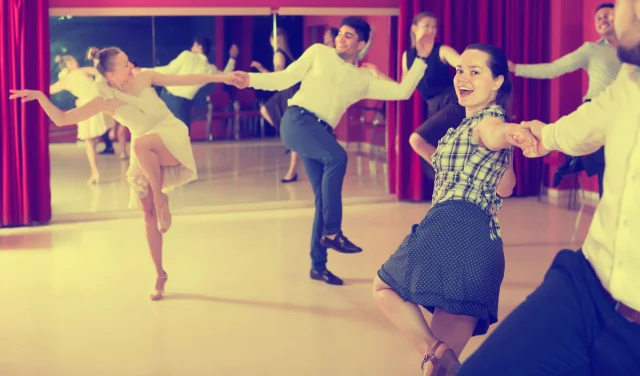Viennese waltz in Switzerland
A UNESCO cultural heritage
If you are looking for a dance style that is both elegant and exhilarating, the Viennese Waltz is perfect for you. In this blog post, you'll learn everything you need to know about the Viennese Waltz: from its history and basic steps to the best songs and the health benefits of this timeless dance.
What is the Viennese Waltz?
The Viennese Waltz is a classic ballroom dance that originated in Vienna, Austria, in the late 18th century. It is characterized by its fast tempo, rotating movements, and elegant flow. Unlike the Slow Waltz, the Viennese Waltz is danced at a brisk pace, typically around 180 beats per minute, making it one of the fastest ballroom dances. This dance is often performed at formal events and competitions, showcasing grace and precision.
How to Dance the Viennese Waltz
The Viennese Waltz is danced in a closed dance hold, with partners maintaining a close connection throughout the dance. The key to mastering this dance lies in the smooth execution of turns and maintaining a steady rhythm. Here are the basic steps and techniques you need to master the Viennese Waltz.
Basic Steps of the Viennese Waltz
The basic steps of the Viennese Waltz are simple but require practice to perform seamlessly at high speeds. Here are the fundamental steps:
Natural Turn
- Starting Position: Stand facing your partner in a closed dance hold.
- Step 1: The leader steps forward with the right foot, while the follower steps back with the left foot.
- Step 2: The leader steps to the side with the left foot, while the follower steps to the side with the right foot.
- Step 3: The leader closes the right foot to the left foot, completing the turn, while the follower closes the left foot to the right foot.
- Steps 4-6: Repeat the steps to continue turning to the right.
Reverse Turn
- Starting Position: Begin in a closed dance hold.
- Step 1: The leader steps forward with the left foot, while the follower steps back with the right foot.
- Step 2: The leader steps to the side with the right foot, while the follower steps to the side with the left foot.
- Step 3: The leader closes the left foot to the right foot, completing the turn, while the follower closes the right foot to the left foot.
- Steps 4-6: Repeat the steps to continue turning to the left.
These basic steps form the foundation for many other figures and variations in the Viennese Waltz.
Top 10 Songs for the Viennese Waltz
Choosing the right music is crucial to fully enjoying your Viennese Waltz dance. Here are our top 10 songs that are perfect for the Viennese Waltz:
- "The Blue Danube" - Johann Strauss II
- "Waltz of the Flowers" - Pyotr Ilyich Tchaikovsky
- "Voices of Spring" - Johann Strauss II
- "Tales from the Vienna Woods" - Johann Strauss II
- "Emperor Waltz" - Johann Strauss II
- "Danube Waves" - Ion Ivanovici
- "Wine, Women and Song" - Johann Strauss II
- "The Second Waltz" - Dmitri Shostakovich
- "Waltz No. 2" - Dmitri Shostakovich
- "Gold and Silver Waltz" - Franz Lehár
These songs offer the perfect tempo and atmosphere to enjoy your Viennese Waltz.
Styles of the Viennese Waltz
While the Viennese Waltz is often danced in its classic form, there are different styles and variations that dancers can choose from depending on their preferences and the occasion.
Traditional Viennese Waltz
This style stays true to traditional techniques and figures and is often danced to classical waltz music. The movements are smooth and graceful, with a strong focus on posture and precision.
Modern Viennese Waltz
The modern Viennese Waltz can be danced to contemporary music and allows more creative freedom in interpretation and improvisation. This style is especially popular among younger dancers and can incorporate elements from other dance styles.
Competitive Viennese Waltz
In competitive Viennese Waltz, dancers perform with precision and technical excellence, often incorporating advanced figures and variations. This style is seen in dance competitions and requires a high level of technique and physical fitness.
History of the Viennese Waltz
The Viennese Waltz has its roots in the late 18th century in Vienna, Austria. It evolved from the Ländler, a traditional Austrian folk dance, and quickly became popular in the ballrooms of Vienna. The Viennese Waltz is known for its fast tempo and continuous turning movements, which were considered revolutionary at the time.
Throughout the 19th century, the Viennese Waltz continued to evolve and gained popularity across Europe and beyond. Composers like Johann Strauss II contributed to its prominence by composing iconic waltz music that is still beloved today. The Viennese Waltz became a staple of ballroom dance and remains a symbol of elegance and sophistication.
Health Benefits of the Viennese Waltz
Dancing in general, and the Viennese Waltz in particular, offers numerous health benefits:
- Cardiovascular Fitness: The fast-paced movements in the Viennese Waltz promote cardiovascular health and increase stamina.
- Coordination and Balance: The complex footwork and various turns improve coordination and balance.
- Stress Relief: Dancing helps to reduce stress and lift your mood.
- Social Interaction: Dancing allows you to meet new people and make social connections, which is good for mental health.
- Cognitive Skills: Learning new dance steps and figures promotes cognitive skills and keeps the brain fit.
Outfit for the Viennese Waltz
The right outfit can highlight your Viennese Waltz dance style and provide you with comfort. Here are some tips for the perfect Viennese Waltz outfit:
For Women:
- Dresses and Skirts: Opt for lightweight, flowing dresses and skirts that allow freedom of movement.
- Shoes: Choose dance shoes with a low heel and a smooth sole for optimal turns.
- Accessories: Keep it simple; a pair of earrings or a bracelet is enough.
For Men:
- Pants: Choose comfortable pants that allow plenty of room for movement.
- Shirts: An elegant shirt is always a good choice. Make sure it is not too tight.
- Shoes: Dance shoes with a smooth sole are ideal for effortless turns and steps.
Conclusion
The Viennese Waltz is a fascinating and elegant dance style that delights both beginners and experienced dancers. With its rich history, diverse dance styles, and health benefits, the Viennese Waltz offers a perfect mix of challenge and fun. If you are looking for a new hobby or want to expand your dance skills, try the Viennese Waltz!
Find your dance partner on Lets-Dance and start your Viennese Waltz adventure today. Enjoy dancing!
Other dance partners
Shop
Popular blog posts about dancing
Create your dance profile on Lets-Dance
Register your dance school
Top cities
Top dances




